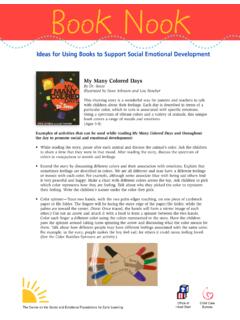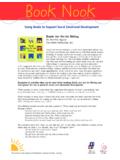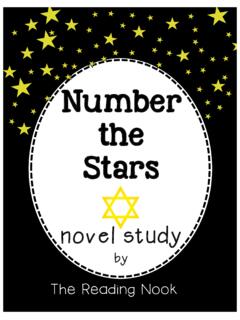Transcription of AQA Literature Paper One - Salendine Nook High School
1 Salendine Nook High School Academy AQA Literature Paper One A Christmas Carol Revision Guide Name: _____ Exam Date: _____ REMINDER In the exam, you will be presented with a short extract from the novella. There will only be ONE question on A Christmas Carol you MUST answer it! The question will ask you to focus on and idea or character so you can show your understanding of the whole text. You can then demonstrate your word level language analysis by finding further evidence from the extract. You are advised to spend 15 minutes planning, using your highlighter pen, margin notes and mind map, 30 minutes writing your response and then 5 minutes carefully proof-reading it for SPAG accuracy!
2 (You will have already spent the previous 50 minutes in this exam writing your response to the question on Shakespeare s Macbeth. You have 1 hour 45 minutes for the whole Paper . HOW SHOULD I REVISE? 1. Let s start with reminding yourself about the novella, its author and the social and historical context see pages 2 4. Once you ve done this, put a tick next to this step. 2. Done? Excellent. Now look at the sample exam question (unfortunately, we don t have any old papers as this is a new specification) on page 5. Once completed put a tick next to this second step. 3. Let s now look at what the examiners are looking for and how you should respond to a question.)
3 You ll find all of this information on page 6. Once completed, put a tick next to this third step. 4. Right, here are the good quotes that we came up with in class as well as what you could say about them for AO2 and AO3. See pages 7 10. Read through this table and put a tick next to this once completed. 5. The blank table on page 11 should be used to plan for possible questions. I would suggest picking a theme from page 6 and then create a possible question, How does Dickens present the supernatural? Your eventual aim is to do this without referring to pages 7 10. Once you have done this for each of the possible themes, put a tick in this box.
4 6. You ll find that some quotes will be useful for pretty much any question those are your gold quotes! Make revision flash cards for these quotes to help you memorise them. It s vital that you memorise as many of these quotes as possible AND that you know what you re going to say about them ( AO2 & AO3). This is one of the most important revision steps so spend time on it. Once completed put a tick next to this step. 7. And finally, practise, practise, practise (in timed conditions 45 minutes and with your quotes memorised). The more you do, the better (and quicker) you ll get and the more prepared you ll be.
5 Put in the time and you will have no regrets in August. Dickens Life Charles Dickens was born in 1812 in Kent and moved to London at the age of 9. When he was 12 years of age, his father was arrested and sent to a debtors' prison. Dickens' mother moved seven of their children into prison with their father but took Charles out of School and arranged for him to live alone outside the prison, working with other child labourers in a terrible job which involved pasting labels on bottles in a blacking (shoe polish) warehouse; he was poorly paid and the conditions were terrible. After his father was released from prison, Dickens returned to School , becoming a law clerk and then a court reporter where he saw the harsh justice system first-hand.
6 He used his own experiences of growing up in Kent and working as a court reporter in his stories. Dickens shocked audiences of his day with his novels, where gentlemen (the ones with the wealth and education) are the least morally good characters and a convict turns out to be the most like a gentleman. He campaigned for a fairer justice system, a reform of the workhouses, the rights of the poor (particularly children) to have access to education, effective sewers and reasonable housing; many of his novels deal with these topics. With such colourful characters, riveting narratives and wonderfully descriptive language, Dickens became one of the most popular English novelists of his time, both in England and America.
7 In 1870, he eventually collapsed from overwork and died. Social and Historical Context Dickens was born into a time of great change in the way people lived. The industrial revolution was taking place and there was a sudden growth of the cities the economy shifted from agriculture to industry and trade. Money from industry made the rich, richer and the rich/poor gap widened. Workers had to toil for long hours and little money. Out of necessity, children of all ages (even as young as five years old!) didn t go to School and worked long hours for a wage in 1840s Britain. The housing was appalling for working class families who lived in squalor, deprivation, disease and misery.
8 They barely had enough money to buy food and the child mortality was very high. In the poorer quarters of Britain's larger cities almost 1 in 5 children born in the 1830s and 40s had died by the age of five. The main causes of death were polluted drinking water, damp and tuberculosis, which claimed between 60,000 and 70,000 lives in each decade of Victoria's reign. There was no healthcare if you got ill and couldn't work, your whole family was at risk of death. For those who were unable to support themselves, there were the workhouses: these were not intended as pleasant places to stay. Men, women and families were separated and those who were physically able were expected to work for their keep.
9 Similar to the workhouses were debtors' prisons (those who were unable to pay a debt), such as Marshalsea, where Charles Dickens' father spent time. The wealthy few on the other hand, lived in luxury with large houses, plenty of money, food and clothes. Their children didn t work, were educated, had expensive toys and often went on holiday. Being seen to be civilised and adhering to a strict set of morals was important to high society in the Victorian age. However, this was often criticised as being hypocritical for some of the reasons mentioned above. Controversially there was a call for a Sunday Observance Bill (by the MP, Andrew Agnew) which would ban any business or recreations taking place on a Sunday.
10 Those who supported it believed that it would ensure that Sunday remained a spiritual day. Those who opposed it (Dickens was one of those he wrote a scathing essay about Andrew Agnew) saw it as an attack on the poor who used Sundays to do what they liked. So, why do you think that Scrooge s character attacks this idea when speaking to the Ghost of Christmas Present? A Christmas Carol During this time of unrelenting social change, Dickens wrote A Christmas Carol. Firstly, he wanted to write a good 'ghost' tale a few scares, a few laughs, a few tears to cheer up families around the hearth at winter (and to pay for his own turkey, no doubt); telling ghost-stories at Christmas-time was a long-standing tradition (many Victorians believed in ghosts coming back to haunt people) and the gothic genre was popular throughout the 19th century.








